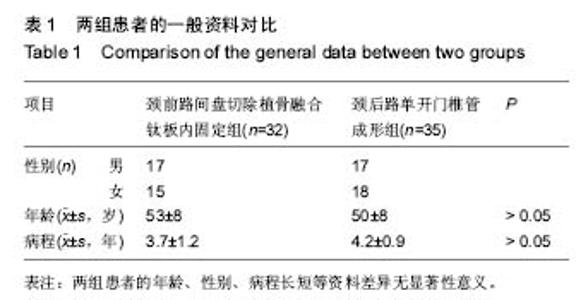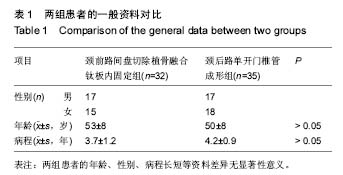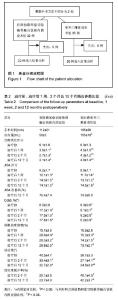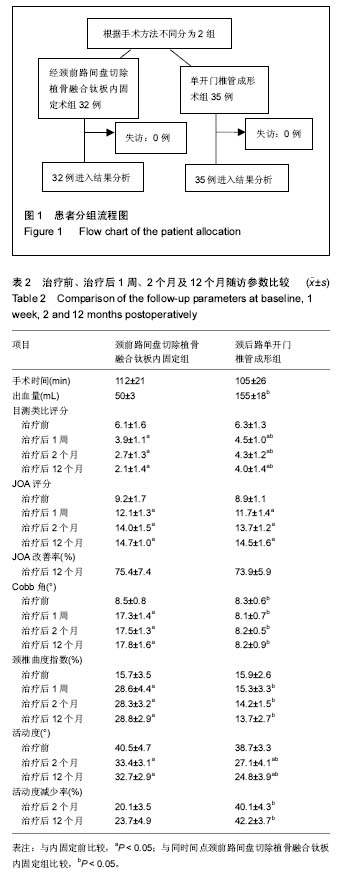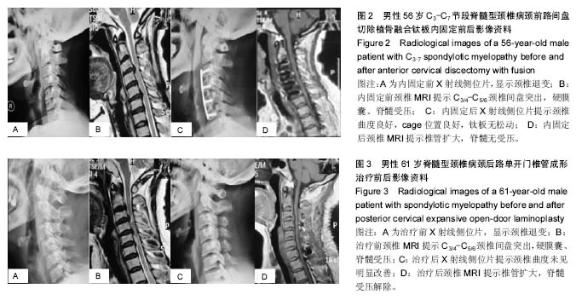| [1] 唐延军,刘建锋,王宪俊,等. 经关节螺钉、侧块螺钉在颈椎后路双向内固定术中的应用[J]. 中国临床研究,2010,23(2): 103-105.[2] 黄玉国,申勇,丁文元,等. 前后路手术治疗脊髓型颈椎病伴椎管狭窄[J]. 中国矫形外科杂志,2009,19(17):1508-1509.[3] Kato Y, KanchiKu T, Imajo Y, et al. Biomechanical study of the effect of degree of static compression of the spinal cord in ossification of the posterior longttudinal ligament. J Neurosurg Spine. 2010; 23: 301-305. [4] Hao Xirong, Zhao Yibo, Lu Xiangdong, et al. Comparison of the effects of different fixation methods on open-door side in posterior expansive open-door laminoplasty. Chin J Orthop. 2017; 37(8): 449-456. [5] Yu S,Li F,Yan N,et al.Anterior fusion technique for multilevel cervical spondylotic myelopathy:a retrospective analysis of surgical outcome of patients with different number of levels fused.PLoS One.2014;9(3):e91329.[6] Qi Min, Wang Xinwei, Liu Yang, et al. Comparative analysis of complications of different anterior decompression procedures for treating multilevel cervical spondylotic myelopathy. Chinese Journal of Spine and Spinal Cord. 2012; 22(11): 963-968.[7] Zhen HL,Guy RF,Na W,et al.Biomechanics of artificial disc replacements adjacent to a 2-Level fusion in 4-level hybrid,constructs:an in vitro investi-gation.Med Sei Monit. 2015;21:4006-4014.[8] 孙凡磊,申勇,聂志红,等. 两种颈后路单开门手术方法对颈椎曲度指数及活动度的影响[J]. 中国矫形外科杂志,2012, 20(11): 975-977.[9] Yu B, Xia YP, Du WJ, et al. A control study of C5 palsy after expansive open-door laminoplasty with miniplate or suture/anchor fixation. Chin J Orthop. 2015;35(1): 11-17.[10] zhang H,Lu S,Sun T,et al.Effect of lamina open angles in expansion open-doorlaminoplasty on the clinical results in treating cervical spondylotic myelopathy.J Spinal Disord Tech.2015;28(3):89-94.[11] 侯铁胜,严宁,虞舜志,等.前路手术治疗4节段脊髓型颈椎病的疗效分析[J].中华骨科杂志,2015,35(11):1129-1135.[12] 袁文,刘洋,陈德玉,等.重度颈椎后凸畸形的手术治疗[J].中华骨科杂志,2007,27(3):671-676.[13] Keith D, Luk MD, Kamath V, et al. Cervical laminoplasty[J]. Eur Spine J, 2010, 19: 347-348.[14] Qian C,Chen XS.Progress on complications of cervical spine surgery. Chin J Orthop.2016; 36(17):1133-1141.[15] 张为,陈百成,申勇,等. 颈3椎板切除单开门成形术对颈椎轴性症状的影响[J]. 中华骨科杂志,2006,26(8):544-548. [16] Cao Rui, Liang Weidong, An Zhongcheng, et al.The efficacy of unilateral open-door laminoplasty with reserved bilateral semispinalis in treating multilevel cervical diseases.Chin J Orthop. 2017; 37(3): 153-161.[17] Sakaura H, Hosono N, Mukai Y, et al. Preservation of muscles attached to the c2 and c7 spinous processes rather than subaxial deep extensors reduces adverse effects after cervical laminoplasty. Spine(Phila Pa 1976). 2010; 16: 782-786.[18] Fujibayashi S, Neo M, Yoshida M, et al. Neck muscle strength before and after cervical laminoplasty: relation to axial symptoms. J Spinal Disord Tech. 2010; 3: 197-202.[19] Shen QF, Xu TT, Xia YP.Comparison of the outcomes between anterior cervical discectomy and fusion versus posterior laminectomy and fusion for the treatment of multi-level cervical spondylotic myelopathy combined with cervical kyphosis.Zhonghua Yi Xue Za Zhi. 2016; 96(47): 3800-3804.[20] Darryl L,John E,Hai L,et al.A controlled anterior sequential interbody dilation technique for correction of cervical kyphosis.J Neurosurg Spine.2015;23(3):263-273.[21] Jiang L,Tan M,Dong L,et al.Comparison of Anterior Decompression and Fusion With Posterior Laminoplasty for Multilevel Cervical Compressive Myelopathy:A Systematic Review and Meta-Analysis.J Spinal Disord Tech.2015; 28(8):282-290.[22] Rihn JA, Kane J, Albert TJ, et al. What is the incidence and severity of dysphagia after anterior cervical surgery? Clin Orthop Relat Res. 2011; 469: 658-665. [23] Lee MJ, Bazaz R, Furey CG, et al. Risk factors for dysphagia after anterior cervical spine surgery: a two-year prespective cohort study. Spine J. 2007;7(2):141-147.[24] Lang Zhao, Tian Wei, He Da, et al. Risk factors for early complications after anterior cervical spine surgery. Chin J Orthop. 2017; 37(3): 162-168.[25] Miyamoto H,Maeno K,Uno K,et al.Outcomes of surgicalintervention for cervical spondylotic myelopathy accompanying local kyphosis(comparison between laminoplasty alone and posterior reconstruction surgery using the serew-rod system).Eur Spine J.2014;23(2):341-346.[26] Wang LN,Wang L,Song YM,et al.Clinical and radiographic outcome of unilateral open-door laminoplasty with alternative levels centerpiece miniplate fixation for cervical compressive myelopathy:a five-year folIow-up study.Int Orthop.2016; 40(6):1267-1274.[27] Liu XW, Chen DY, Wang B, et al. The difference of axial pain between patients accepting C3-C7 or C3-C6 one-door-open laminoplasty. Chinese Journal of Spine and Spinal Cord.2012, 22(11): 989-993.[28] Mori E,Ueta T,Maeda T,et al.Effect of preservation of the C-6 spinous process and its paraspinal muscular attachment on the prevention of postoperative axial neck pain in C3-6 laminoplasty. J Neurosurg Spine.2015;22(3):221-229.[29] 陈华,刘浩,邹黎,等.不同固定方法对颈椎单开门椎管扩大成形术铰链侧骨断端愈合的影响[J].中国脊柱脊髓杂志,2013, 23(7): 599-605.[30] Chen H,Liu H,Deng Y,et al.Multivariate a11alysis of factors associated with axial symptoms in unilateral expansive open-door cervical laminoplasty with mini-plate fixation. Medicine(Baltimore).2016;95(2):e2292.[31] Dimar JR 2nd,Bratcher KR,Brock DC,et al.Instrumented open-door laminoplasty as treatment for cervical myelopathy in 104 patients.Am J Orthop(Belle Mead NJ).2009;38(7):E123-E128.[32] Xu Xiaonuo,Liu Haiying.Clinical analysis of cervical posterior internal fixation titanium plate and silk suspension internalfixation cervical spondylosis.Chin J Surg,March 2017;55(3): 214-219.[33] Otani K,Sato K,Yabuki S,et al.A segmental partial laminectomy for cervical spandylotic myelopathy:anatomical basis and chinical outcome in comparison with expansive open-door laminoplasty.Spine(Phila Pa 1976).2009;34(3) : 268-273[34] ZHA O Bo,QIN Jie,WANG Dong,et al.Case-control study of anterior cervical decompression plus sublevel fusion and posterior cervical laminoplasty for the treatment of multilevel cervical spondylotic myelopathy. China J Orthop Trauma. 2016;29(3):205-210.[35] 魏磊鑫,田野,华东方,等.多节段脊髓型颈椎病伴髓内MRI T2WI高信号改变患者的手术入路选择及疗效分析[J].中国脊柱脊髓杂志,2016,26(2):101-107. |
